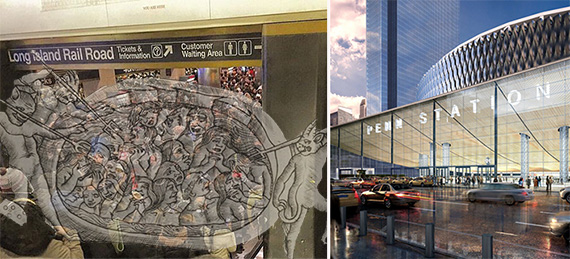Some of the city’s most prominent developers and designers are vying for a challenge put forth by Gov. Andrew Cuomo: Make Penn Station less hellish.
Requests for proposals (RFPs) for the redevelopment of Penn Station and the James A. Farley Post Office — collectively called “Empire Station Complex” — are due Friday, three months after Cuomo kickstarted the plans and temporarily dropped Vornado Realty Trust and Related Companies from the Farley project, known as Moynihan Station. Those who submit proposals have a choice to either redevelop both Penn Station and Moynihan, or tackle the projects individually.
At least 10 developers have expressed interest in taking on the projects. Among the suitors: Extell Development, Silverstein Properties, Tishman Speyer, JDS Development Group and Brookfield Property Partners, along with Vornado and Related.
These companies toured the facilities in February and March, according to a list of attendees provided by the Empire State Development Corporation, one of the leading state agencies on the projects.
Also in attendance were major construction companies with design-build experience, such as Tishman Construction and Turner Construction. Skanska, which is working on the first phase of Moynihan Station — a portion of the project that was underway before the RFP was issued and will create access to Penn Station tracks in the Post Office — and the overhaul of LaGuardia Airport also toured the sites.
The RFPs offer five design options for the redevelopment of Penn Station, one of which includes removing Madison Square Garden’s Paramount Theater to create an entrance at Eighth Avenue. Across the street, Moynihan Station would be transformed into a train hall for AMTRAK.
Vornado and Related have a considerable leg up on the competition, having studied the project since Gov. George Pataki tapped them to jointly develop it in 2005. Both companies are also big players in the neighborhood: Vornado has amassed 9 million square feet of office space, and Related is behind the Hudson Yards megaproject on the Far West Side.
“There’s no way around it, they should know the building better than anybody else,” said Jonathan Gouveia, who heads The Municipal Art Society’s Penn 2023, an advocacy campaign aimed at improving the regional rail system and Penn Station. “I think they [Vornado and Related] both would have very competitive bids.”
Outsider architecture firms may also be facing an uphill climb. The RFPs require prospective developers to piggyback off of Skidmore, Owings & Merrill’s designs for the Farley Building unless the project’s sponsors — Empire State Development, AMTRAK, the Metropolitan Transportation Authority and Long Island Rail Road — agree to exceptions. SOM has been involved in the development since the late 1990s.
Candidates would need deep pockets, the ability to tackle complex transportation projects and experience with design-build, the preferred contract delivery system. The project is estimated to cost $3 billion — though Cuomo has twice publicly, by accident according to his representatives, put the estimate at $8 billion — and the development team is expected to foot the bulk of that bill.
Vidaris, an engineering and architecture consulting firm that has worked on One World Trade Center, 15 Hudson Yards and 432 Park Avenue, is part of one of the teams submitting proposals on Friday, said the firm’s CEO Marc Weissbach. He wouldn’t specify the team but said the company was drawn to the importance of overhauling Penn Station.
“Overall if it goes forward, and they’ve been talking about this for some time, the project that they are contemplating is a pretty spectacular project,” he said. “That piece of real estate in New York, I couldn’t imagine what it’s worth. It’s just an incredible site.”
The winners will have their work cut out for them. Jeff Dugan, who heads the transportation practice at Dattner Architects, said the fact that Penn Station must remain open while the work is underway makes the projects even trickier.
“Think of the World Trade Center. That was like a chess board to get things moving there,” he said. “It’s a real maze of work. I’d put the redevelopment of Penn Station right up there in terms of complexity.”
Though it was among the companies that toured Penn Station, Dattner isn’t bidding on the RFPs. The company, however, might try to take on other changes in the area not mentioned in the RFP, like the Gateway Tunnel Project, which would create a new rail tunnel linking New Jersey and New York, and the proposed expansion of Penn Station at the platform level, known as Penn Station South.
The RFP doesn’t include relocation plans for Madison Square Garden, even though its operating permit with the city expires in seven years. The Municipal Art Society has been especially vocal about the need to move the stadium, saying the RFPs are missing a big-picture look at the area’s transportation needs.
In the last few months, Cuomo has taken to referring to Penn Station as “designed by Dante,” almost gleeful in his comparison of the transit hub to various circles of hell. At last check, he compared it to the seventh, which according to Dante, is “a place of intense torture where the horrific screams of the damned are eternally accompanied by the hellish beats of drums.”
